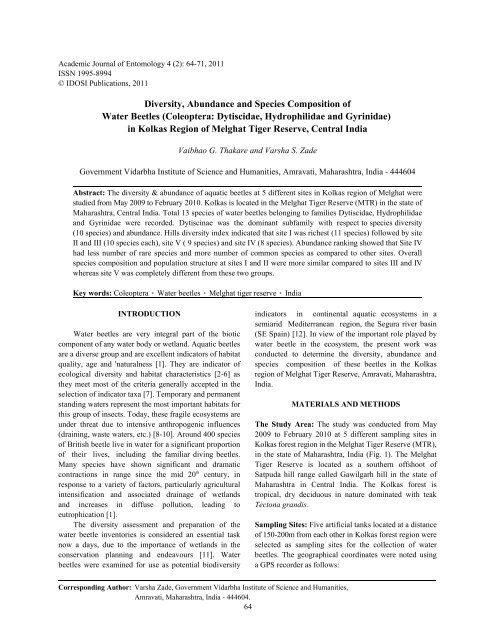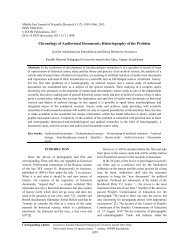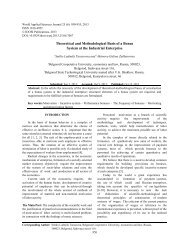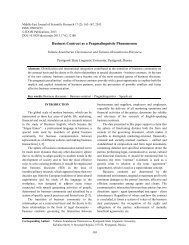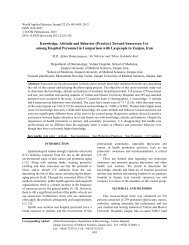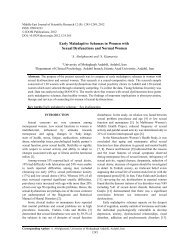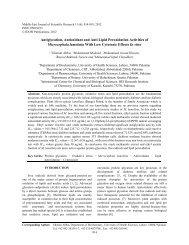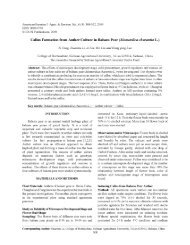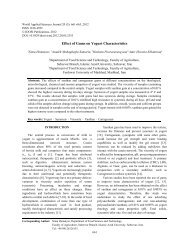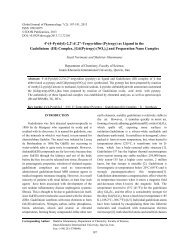Diversity, Abundance and Species Composition of Water ... - Idosi.org
Diversity, Abundance and Species Composition of Water ... - Idosi.org
Diversity, Abundance and Species Composition of Water ... - Idosi.org
Create successful ePaper yourself
Turn your PDF publications into a flip-book with our unique Google optimized e-Paper software.
Academic Journal <strong>of</strong> Entomology 4 (2): 64-71, 2011<br />
ISSN 1995-8994<br />
© IDOSI Publications, 2011<br />
<strong>Diversity</strong>, <strong>Abundance</strong> <strong>and</strong> <strong>Species</strong> <strong>Composition</strong> <strong>of</strong><br />
<strong>Water</strong> Beetles (Coleoptera: Dytiscidae, Hydrophilidae <strong>and</strong> Gyrinidae)<br />
in Kolkas Region <strong>of</strong> Melghat Tiger Reserve, Central India<br />
Vaibhao G. Thakare <strong>and</strong> Varsha S. Zade<br />
Government Vidarbha Institute <strong>of</strong> Science <strong>and</strong> Humanities, Amravati, Maharashtra, India - 444604<br />
Abstract: The diversity & abundance <strong>of</strong> aquatic beetles at 5 different sites in Kolkas region <strong>of</strong> Melghat were<br />
studied from May 2009 to February 2010. Kolkas is located in the Melghat Tiger Reserve (MTR) in the state <strong>of</strong><br />
Maharashtra, Central India. Total 13 species <strong>of</strong> water beetles belonging to families Dytiscidae, Hydrophilidae<br />
<strong>and</strong> Gyrinidae were recorded. Dytiscinae was the dominant subfamily with respect to species diversity<br />
(10 species) <strong>and</strong> abundance. Hills diversity index indicated that site I was richest (11 species) followed by site<br />
II <strong>and</strong> III (10 species each), site V ( 9 species) <strong>and</strong> site IV (8 species). <strong>Abundance</strong> ranking showed that Site IV<br />
had less number <strong>of</strong> rare species <strong>and</strong> more number <strong>of</strong> common species as compared to other sites. Overall<br />
species composition <strong>and</strong> population structure at sites I <strong>and</strong> II were more similar compared to sites III <strong>and</strong> IV<br />
whereas site V was completely different from these two groups.<br />
Key words: Coleoptera <strong>Water</strong> beetles Melghat tiger reserve India<br />
INTRODUCTION<br />
indicators in continental aquatic ecosystems in a<br />
semiarid Mediterranean region, the Segura river basin<br />
<strong>Water</strong> beetles are very integral part <strong>of</strong> the biotic (SE Spain) [12]. In view <strong>of</strong> the important role played by<br />
component <strong>of</strong> any water body or wetl<strong>and</strong>. Aquatic beetles water beetle in the ecosystem, the present work was<br />
are a diverse group <strong>and</strong> are excellent indicators <strong>of</strong> habitat conducted to determine the diversity, abundance <strong>and</strong><br />
quality, age <strong>and</strong> 'naturalness [1]. They are indicator <strong>of</strong> species composition <strong>of</strong> these beetles in the Kolkas<br />
ecological diversity <strong>and</strong> habitat characteristics [2-6] as region <strong>of</strong> Melghat Tiger Reserve, Amravati, Maharashtra,<br />
they meet most <strong>of</strong> the criteria generally accepted in the India.<br />
selection <strong>of</strong> indicator taxa [7]. Temporary <strong>and</strong> permanent<br />
st<strong>and</strong>ing waters represent the most important habitats for<br />
MATERIALS AND METHODS<br />
this group <strong>of</strong> insects. Today, these fragile ecosystems are<br />
under threat due to intensive anthropogenic influences The Study Area: The study was conducted from May<br />
(draining, waste waters, etc.) [8-10]. Around 400 species 2009 to February 2010 at 5 different sampling sites in<br />
<strong>of</strong> British beetle live in water for a significant proportion Kolkas forest region in the Melghat Tiger Reserve (MTR),<br />
<strong>of</strong> their lives, including the familiar diving beetles. in the state <strong>of</strong> Maharashtra, India (Fig. 1). The Melghat<br />
Many species have shown significant <strong>and</strong> dramatic Tiger Reserve is located as a southern <strong>of</strong>fshoot <strong>of</strong><br />
th<br />
contractions in range since the mid 20 century, in Satpuda hill range called Gawilgarh hill in the state <strong>of</strong><br />
response to a variety <strong>of</strong> factors, particularly agricultural Maharashtra in Central India. The Kolkas forest is<br />
intensification <strong>and</strong> associated drainage <strong>of</strong> wetl<strong>and</strong>s tropical, dry deciduous in nature dominated with teak<br />
<strong>and</strong> increases in diffuse pollution, leading to Tectona gr<strong>and</strong>is.<br />
eutrophication [1].<br />
The diversity assessment <strong>and</strong> preparation <strong>of</strong> the Sampling Sites: Five artificial tanks located at a distance<br />
water beetle inventories is considered an essential task <strong>of</strong> 150-200m from each other in Kolkas forest region were<br />
now a days, due to the importance <strong>of</strong> wetl<strong>and</strong>s in the selected as sampling sites for the collection <strong>of</strong> water<br />
conservation planning <strong>and</strong> endeavours [11]. <strong>Water</strong> beetles. The geographical coordinates were noted using<br />
beetles were examined for use as potential biodiversity a GPS recorder as follows:<br />
Corresponding Author: Varsha Zade, Government Vidarbha Institute <strong>of</strong> Science <strong>and</strong> Humanities,<br />
Amravati, Maharashtra, India - 444604.<br />
64
Acad. J. Entomol., 4 (2): 64-71, 2011<br />
Fig. 1: Map <strong>of</strong> the study area (Kolkas Region <strong>of</strong> Melghat Tiger Reserve)<br />
Site I 21°29.96’N, 077°12.338’ E widely used Shannon diversity indices were calculated<br />
Site II 21°29.96’N, 077°12.390’ E because it is well accepted that, all species at a site, within<br />
Site III 21°30.020’N, 077°12.515’E <strong>and</strong> across systematic groups contribute equally to its<br />
Site IV 21°30.034’N,077°12.540’ E biodiversity [17]. - diversity, Sample based rarefraction<br />
Site V 21°30.107’N,077°12.578’ E <strong>and</strong> other community composition methods were<br />
calculated using Biodiversity Pro s<strong>of</strong>tware version 2 [18].<br />
These sites were sampled twice every month from<br />
May 2009 to February 2010.<br />
RESULTS<br />
Field Methods: Beetle sampling was carried out at each In the present work 13 water beetles belonging to<br />
site at an interval <strong>of</strong> 15 days. The water beetles were family Dytiscidae, Hydrophilidae & Gyrinidae were<br />
collected from the study area with the help <strong>of</strong> aquatic recorded from the Kolkas region <strong>of</strong> Melghat Tiger<br />
nets. The collected water beetles were sorted <strong>and</strong> Reserve. Literature survey has revealed that all the<br />
preserved in 70 % alcohol. The collected specimens were species have been recorded for the first time from Melghat<br />
then brought back to the laboratory, pinned, dried <strong>and</strong> Tiger Reserve. The maximum numbers <strong>of</strong> dytiscid beetles<br />
identified with the help <strong>of</strong> st<strong>and</strong>ard identification manuals were observed in the month <strong>of</strong> September 2009. Some<br />
<strong>and</strong> published literature [13-16].<br />
specimens had filiform antennae which were not<br />
Identity <strong>of</strong> the beetle specimens were later confirmed pubescent, palps not enlarged; the hindlegs <strong>of</strong> all species<br />
by the experts from Zoological Survey <strong>of</strong> India, Pune, were flattened <strong>and</strong> fringed with long hairs to form<br />
India.<br />
excellent paddles characteristics <strong>of</strong> family Dytiscidae.<br />
These specimens had eyes unnotched at antennal bases<br />
Data Analysis: Two components, namely -diversity <strong>and</strong> males had protarsal segments 1-3 modified to form a<br />
(diversity within the habitat) & -diversity (between the large, broad, oval palette, <strong>of</strong>ten with variable number <strong>of</strong><br />
habitats) were calculated. Measures <strong>of</strong> -diversity, the suckers on the ventral surface, characteristic <strong>of</strong> subfamily<br />
65
Acad. J. Entomol., 4 (2): 64-71, 2011<br />
Fig. 2: Different morphological characters <strong>of</strong> Family Dytiscidae<br />
Fig. 3: Different morphological characters <strong>of</strong> Family Hydrophilidae<br />
Dytiscinae (Fig. 2). Two <strong>of</strong> the collected beetles were oval, in appearance to the Dytiscidae. The aquatic species are<br />
somewhat convex that could be recognized by the short generally black in color <strong>and</strong> the metasternum in many<br />
clubbed antennae <strong>and</strong> the long maxillary palps species is prolonged posteriorly as a sharp spine [13]. The<br />
characteristics <strong>of</strong> family Hydrophilidae (Fig. 3). Most <strong>of</strong> Gyrinids are oval black beetles that are commonly seen<br />
the species <strong>of</strong> Hydrophilidae are aquatic <strong>and</strong> very similar swimming in endless gyrations on the surface <strong>of</strong> pond<br />
66
Acad. J. Entomol., 4 (2): 64-71, 2011<br />
<strong>Water</strong> Beetle <strong>Species</strong> <strong>Composition</strong>: Overall 8 genera<br />
comprising 13 beetle species from 3 families were recorded<br />
during the present study (Table 1). Of the family<br />
Dytiscidae, the Dytiscinae was the dominant subfamily in<br />
terms <strong>of</strong> species richness (10 species) <strong>and</strong> abundance,<br />
followed by Hydrophilidae (3 species) <strong>and</strong> Gyrinidae<br />
(1 species) in the surveyed area. All specimens could be<br />
identified to the species level. The Hydaticus <strong>and</strong><br />
S<strong>and</strong>racottus were the most species rich genera with<br />
3 species respectively followed by Cybister (2 species),<br />
Eretes (1 species), Rhantaticus (1 species), Hydrophilus<br />
(1 species), Sternolophus (1 species) <strong>and</strong> Dineutus (1<br />
species) (Table 2).<br />
<strong>Species</strong> <strong>Diversity</strong> & <strong>Abundance</strong> Pattern: The beetles<br />
collected from five different sites were compared <strong>and</strong><br />
Shannon's indices were calculated as a measure <strong>of</strong><br />
diversity within the habitat. Hills diversity index indicated<br />
Fig. 4: Different morphological characters <strong>of</strong> Family that site I was richest (11 species) followed by site II<br />
Gyrinidae<br />
<strong>and</strong> III (10 species each), site V (9 species) <strong>and</strong> site IV<br />
(8 species).The sample size <strong>of</strong> the five different sites were<br />
<strong>and</strong> quite streams.They are extremely rapid swimmers compared <strong>and</strong> Fisher’s diversity <strong>and</strong> Shannon diversity<br />
swimming principally by means <strong>of</strong> the highly flattened indices were calculated as a measure <strong>of</strong> diversity within a<br />
middle <strong>and</strong> hindlegs; the front legs are elongate <strong>and</strong> habitat. The Shannon diversity index indicated that site I<br />
slender. They have a pair <strong>of</strong> compound eyes. was relatively diverse (3.29) followed by site II (3.14),<br />
Table 1: Total number <strong>and</strong> percentage <strong>of</strong> species, genera <strong>and</strong> individuals observed per Family<br />
Genera <strong>Species</strong> Individuals<br />
------------------------------- ---------------------------------- -------------------------------------<br />
Subfamily No % No % No %<br />
Dytiscidae 5 62.50 10 76.92 75 67.56<br />
Hydrophilidae 2 25.00 2 15.38 16 14.41<br />
Gyrinidae 1 12.50 1 7.69 20 18.01<br />
Total (3) 8 100.00 13 100.00 111 100.00<br />
Table 2: List <strong>of</strong> water beetles recorded from the study area<br />
Family Subfamily Tribe Genus, <strong>Species</strong> Length in Cm<br />
Dytiscidae (Leach,1815) Dytiscinae (Leach,1815) Cybistrini (Sharp,1882) Cybister confusus (Sharp, 1882) 2.6<br />
Dytiscidae (Leach,1815) Dytiscinae (Leach,1815) Cybistrini (Sharp, 1882) Cybister tripunctatus (Sharp, 1882) 3.7<br />
Dytiscidae (Leach,1815) Dytiscinae (Leach,1815) Eretini (Crotch,1873) Eretes sticticus (Linnaeus, 1833 ) 1.3<br />
Dytiscidae (Leach,1815) Dytiscinae (Leach,1815) Hydaticini (Sharp, 1882) Hydaticus fabricii (MacLeay,1833) 1.1<br />
Dytiscidae (Leach,1815) Dytiscinae (Leach,1815) Hydaticini (Sharp, 1882) Hydaticus vittatus (Fabricius, 1838) 1.5<br />
Dytiscidae (Leach,1815) Dytiscinae (Leach,1815) Hydaticini (Sharp, 1882) Hydaticus luczonicus (Aube,1838 ) 1.4<br />
Dytiscidae (Leach,1815) Dytiscinae (Leach,1815) Thermonectini (Sharp, 1882) Rhantaticus congestus (Klug, 1833) 1.5<br />
Dytiscidae (Leach,1815) Dytiscinae (Leach,1815) Thermonectini (Sharp, 1882) S<strong>and</strong>racottus dejeanii (Aube, 1838 ) 1.4<br />
Dytiscidae (Leach,1815) Dytiscinae (Leach,1815) Thermonectini (Sharp, 1882) S<strong>and</strong>racottus mixtus (Blanchard, 1853) 1.5<br />
Dytiscidae (Leach,1815) Dytiscinae (Leach,1815) Thermonectini (Sharp, 1882) S<strong>and</strong>racottus sp. (Sharp,1882) 1.1<br />
Hydrophilidae (Latreille,1802) Hydrophilinae (Latreille,1802) Hydrophilini (Latreille,1802) Hydrophilus olivaceous (Muller,1764) 3.1<br />
Hydrophilidae (Latreille,1802) Hydrophilinae (Latreille,1802) Hydrophilini (Latreille,1802) Sternolophus rufipes (Solier,1834) 1.3<br />
Gyrinidae (Latreille,1810) Enhydrinae (Latreille,1810) Enhydrini (Regimbart, 1882) Dineutus indicus (Aube,1838) 1.5<br />
67
Acad. J. Entomol., 4 (2): 64-71, 2011<br />
Table 3: Alpha diversity indices for different sites at Kolkas region <strong>of</strong> Melghat Tiger Reserve<br />
Index Site I Site II Site III Site IV Site V<br />
Fisher -diversity 8.27 7.957 7.478 3.947 5.965<br />
Shannon H' 3.295 3.146 3.001 2.588 2.892<br />
Simpsons (D) 0.071 0.079 0.11 0.166 0.119<br />
Hills No (H0) 11 10 10 8 9<br />
Shannon J 0.952 0.947 0.903 0.863 0.912<br />
8<br />
<strong>Abundance</strong> Plot<br />
15<br />
Rarefaction Plot<br />
6<br />
10<br />
<strong>Abundance</strong><br />
4<br />
Site I<br />
2<br />
Site II<br />
Site III<br />
Site IV<br />
Site V<br />
0<br />
1 10 100<br />
Rank<br />
Fig. 5: <strong>Species</strong> rank abundance plot for five different sites<br />
ES(n)<br />
5<br />
n<br />
Site I<br />
Site II<br />
Site III<br />
Site IV<br />
Site V<br />
0<br />
0 5 10 15 20 25<br />
Fig. 6: Sample based rarefraction curve for different sites<br />
site III (3.00), site V (2.89) <strong>and</strong> lastly the site IV (2.58). The<br />
Simpson <strong>and</strong> Shannon J (evenness) indices also revealed<br />
almost the same order <strong>of</strong> diversity <strong>of</strong> sites (Table 3).<br />
<strong>Species</strong> were ranked according to their abundance.<br />
Common species are displayed on the left <strong>and</strong> the rare<br />
species are on the right (Fig. 5). <strong>Abundance</strong> ranking<br />
showed that Site IV had less number <strong>of</strong> rare species<br />
(i.e. abundance value 2) <strong>and</strong> more number <strong>of</strong> common<br />
species (i.e. abundance value 7) as compared to other<br />
sites. Site I <strong>and</strong> II were comparable to each other <strong>and</strong> so<br />
was the case with site III <strong>and</strong> V.<br />
Sample Based Rarefraction Curve for Five Different<br />
Transects: Rarefraction curve is shown in Fig. 6. Expected<br />
number <strong>of</strong> species [ES(n)] has been plotted against<br />
number <strong>of</strong> individuals (n). This plot provides a measure <strong>of</strong><br />
species diversity. Steeper curve indicated more diverse<br />
communities. A steeper curve was observed for site I<br />
because <strong>of</strong> its high species diversity. Site II was almost<br />
equally rich followed by site III. Sites V <strong>and</strong> IV were low<br />
in diversity.<br />
Comparison <strong>of</strong> <strong>Species</strong> Turnover among Transects:<br />
To visualize difference in species composition between<br />
the different sites (habitats), a complete linkage <strong>of</strong> Jaccard<br />
(Jaccard similarity matrix- presence/absence)<br />
Fig. 7: Dendrogram comparing different sites by their<br />
water beetle species assemblage<br />
similarity <strong>and</strong> Bray Curtis coefficient matrix was carried<br />
out. The dendrogram clustering <strong>of</strong> the species grouping<br />
<strong>and</strong> habitats grouping was drawn. Jaccard similarity<br />
indices were calculated based on presence <strong>and</strong> absence<br />
<strong>of</strong> particular taxa at different study sites <strong>of</strong> Kolkas region,<br />
whereas Bray Curtis coefficient clustering was calculated<br />
based on the similarity richness <strong>and</strong> abundance <strong>of</strong> water<br />
beetle taxa.<br />
The Jaccard similarity matrix showed very close<br />
similarity between the site V <strong>and</strong> site III which form a<br />
single cluster <strong>and</strong> site I <strong>and</strong> site II formed another cluster.<br />
68
Acad. J. Entomol., 4 (2): 64-71, 2011<br />
Site IV stood apart as an outgroup <strong>of</strong> the cluster<br />
consisting <strong>of</strong> site I <strong>and</strong> II (Fig. 7). Overall species<br />
composition <strong>and</strong> population structure at sites I <strong>and</strong> II<br />
were more similar compared to site III <strong>and</strong> IV whereas site<br />
V was completely different from these two groups (Fig. 8)<br />
Comparison <strong>of</strong> <strong>Species</strong> Turnover among Habitats: The<br />
clustering <strong>of</strong> the species based on their occurrence <strong>and</strong><br />
abundance at different sites were compared by using Bray<br />
Curtis complete linkage clustering (Fig. 9). A striking<br />
similarity was observed between Hydrophilus olivaceus<br />
<strong>and</strong> Cybister tripunctatus. About 80% similarity was<br />
(Bray Curtis similarity matrix- abundance) observed between Dineutus indicus <strong>and</strong> Hydaticus<br />
luczonicus. Similarity in their association pattern was<br />
Fig. 8: Dendrogram comparing different sites by their observed between Rhantaticus congestus <strong>and</strong> Hydaticus<br />
water beetle species pr<strong>of</strong>ile<br />
fabricii <strong>and</strong> Eretes sticticus <strong>and</strong> Hydaticus vittatus.<br />
S<strong>and</strong>racottus species (S<strong>and</strong>racottus mixtus,<br />
S<strong>and</strong>racottus dejeanii <strong>and</strong> an unknown S<strong>and</strong>racottus<br />
species) stood as an outgroup. Whereas Sternolophus<br />
rufipes <strong>and</strong> Cybister confusus were found to be more<br />
independent.<br />
Habitat Preference <strong>Species</strong> Distribution: <strong>Species</strong><br />
distribution <strong>of</strong> water beetle fauna at different sites was<br />
assessed. Almost all the species <strong>of</strong> water beetle showed<br />
r<strong>and</strong>om species distribution (Table 4).<br />
DISCUSSION<br />
Fig. 9: Dendrogram based on the species association <strong>of</strong><br />
water beetle fauna at Kolkas<br />
Aquatic beetles have their greatest abundance <strong>and</strong><br />
diversity in the temperate regions [19]. Aquatic<br />
Coleoptera constitute an important part <strong>of</strong> the<br />
macrozoobenthos <strong>of</strong> freshwater habitats. Small <strong>and</strong><br />
temporary water bodies have more species than large <strong>and</strong><br />
Table 4: Distribution pr<strong>of</strong>ile <strong>of</strong> water beetle fauna at Kolkas region <strong>of</strong> Melghat Tiger Reserve<br />
<strong>Species</strong> Variance Mean Chi-sq d.f. Probability Aggregation<br />
Cybister confusus 0.3 0.6 2 4 0.7387682 R<strong>and</strong>om<br />
Cybister tripunctatus 0.3 0.4 3 4 0.5605026 R<strong>and</strong>om<br />
Eretes sticticus 0.5 2.0 1 4 0.9089377 R<strong>and</strong>om<br />
Hydaticus fabricii 0.7 0.8 3.5 4 0.5203377 R<strong>and</strong>om<br />
Hydaticus vittatus 0.8 1.4 2.2857 4 0.6866165 R<strong>and</strong>om<br />
Hydaticus luczonicus 1.7 4.8 1.4167 4 0.8426009 R<strong>and</strong>om<br />
Rhantaticus congestus 0.3 0.4 3 4 0.5605026 R<strong>and</strong>om<br />
S<strong>and</strong>racottus dejeanii 1.7 2.8 2.4286 4 0.660714 R<strong>and</strong>om<br />
S<strong>and</strong>racottus mixtus 1.2 1.2 4 4 0.4068319 R<strong>and</strong>om<br />
S<strong>and</strong>racottus sp. 0.8 0.6 5.3333 4 0.2537639 R<strong>and</strong>om<br />
Hydrophilus olivaceous 0.3 0.6 2 4 0.7387682 R<strong>and</strong>om<br />
Sternolophus rufipes 3.8 2.6 5.8462 4 0.2096018 R<strong>and</strong>om<br />
Dineutus indicus 4.0 4.0 4 4 0.4068319 R<strong>and</strong>om<br />
69
Acad. J. Entomol., 4 (2): 64-71, 2011<br />
permanent ones [20]. These insects are not selective in Zoological Assistant) <strong>of</strong> ZSI Western Regional Station,<br />
their choice <strong>of</strong> water bodies <strong>and</strong> occur in a wide variety <strong>of</strong> Pune, India for their expert guidance in identification <strong>of</strong><br />
habitats [21], although many species may prefer certain water beetles. Special thanks to Principle Chief<br />
types <strong>of</strong> water bodies [22]. Many <strong>of</strong> them, especially Conservator <strong>of</strong> Forest, Government <strong>of</strong> Maharashtra <strong>and</strong><br />
dytiscids <strong>and</strong> many hydrophilids, are generally found in Conservator <strong>of</strong> Forest, Melghat Tiger Reserve, Amravati,<br />
habitats <strong>of</strong> small shallow water bodies or on the margin <strong>of</strong> Maharashtra for giving the permission to collect the<br />
rivers <strong>and</strong> marshes <strong>and</strong> they occupy the zone <strong>of</strong> emergent specimens <strong>of</strong> beetles from the study area for the purpose<br />
vegetation, mats <strong>of</strong> plant debris, or flooded terrestrial <strong>of</strong> Ph.D. Work.<br />
vegetation along the shoreline [23].<br />
In the present study all the 13 species <strong>of</strong> water<br />
REFERENCES<br />
beetles were collected from temporary water tanks.<br />
Sanchez-Fern<strong>and</strong>ez [12] while investigating the indicator 1. Bilton, V., 2009. Report <strong>of</strong> Aquatic Coleoptera<br />
value <strong>of</strong> water beetle fauna found that the correlation Conservation Trust, I:\print\David Bilton.mht.<br />
values <strong>and</strong> the percentage <strong>of</strong> species represented by 2. Foster, G.N., 1987. The use <strong>of</strong> Coleoptera Records in<br />
family, genus <strong>and</strong> species complementary networks were Assessing the Conservation Status <strong>of</strong> Wetl<strong>and</strong>s. In:<br />
similar <strong>and</strong> suggested that the higher taxa <strong>of</strong> water beetles The Use <strong>of</strong> Invertebrates in Site Assessment for<br />
(genera or families) can be used as biodiversity surrogates Conservation Newcastle upon Tyne, Luff, M.L. (Ed.).<br />
for cost-effective practical surveys. University <strong>of</strong> Newcastle upon Tyne, UK., pp: 8-17.<br />
Kiyak et al. [24] collected 31 aquatic beetle 3.; Eyre, M.D. <strong>and</strong> G.N. Foster, 1989. A comparison <strong>of</strong><br />
specimens from the provinces Denizli, Aydin, Isparta <strong>and</strong> aquatic Heteroptera <strong>and</strong> Coleoptera communities as<br />
Antalya in South-West Mediterranean region <strong>of</strong> Turkey. a basis for environmental <strong>and</strong> conservation<br />
Ostovan et al. [25] studied the diversity, abundance <strong>and</strong> assessments in statistic water sites. J. Appl.<br />
biology <strong>of</strong> aquatic insects, including aquatic beetles, in Entomol., 108: 355-362.<br />
Ardabil <strong>and</strong> Fars Provinces. Cox <strong>and</strong> C ox [26] studied 4. Foster, G.N., A.P. Foster, M.D. Eyre <strong>and</strong> B.T. Bilton,<br />
water beetles <strong>of</strong> the families Dytiscidae, Hydrophilidae, 1990. Classification <strong>of</strong> water beetle assemblages in<br />
Gyrinidae <strong>and</strong> Haliplidae in Amir-Kolayeh <strong>and</strong> the part <strong>of</strong> arable fenl<strong>and</strong> <strong>and</strong> ranking <strong>of</strong> sites in relation to<br />
Anzali. conservation value. Freshwater Biol., 22: 343-354.<br />
In the present study diversity <strong>of</strong> water beetles 5. Ribera, I. <strong>and</strong> G.N. Foster, 1993. Uso de los<br />
belonging to 3 families Dytiscidae, Hydrophilidae & Coleopteros acuaticos como indicadores biologicos<br />
Gyrinidae constituting 13 water beetle species were (Coleoptera). Elytron, 4: 61-75.<br />
recorded. 6. Fern<strong>and</strong>ez, S., D.P. Abellan, J. Velasco <strong>and</strong> A. Millan,<br />
Fauziah [11] studied the diversity <strong>of</strong> coleopteran 2004. Selecting areas to protect the biodiversity <strong>of</strong><br />
water beetles in Kenyir <strong>Water</strong> catchment <strong>of</strong> Terengganu, aquatic ecosystems in semiarid Mediterranean region<br />
Malaysia in which both diversity <strong>and</strong> abundance was using water beetle. Aquatic Conservation: Marine<br />
found to be low with only four species <strong>of</strong> water beetles, <strong>and</strong> Freshwater Ecosystems, 14: 465-479.<br />
indicating that the ecosystem is under stress. The results 7. Pearson, D.L., 1994. Selecting indicator taxa for the<br />
indicated that the diversity <strong>of</strong> the water beetle fauna <strong>of</strong> quantitative assessment <strong>of</strong> biodiversity.<br />
Kolkas region was relatively high (8 genera <strong>and</strong> 13 Philosophical Transactions <strong>of</strong> the Royal Society B.,<br />
species). The water beetle fauna in the present 345: 75-79.<br />
investigation were dominated by the family Dytiscidae 8. Celik, T., I. Zelnik, V. Babij, B. Vres, A. Pirnat, A.<br />
which comprised <strong>of</strong> 76.92% <strong>of</strong> the total species, followed Seliskar <strong>and</strong> B. Drovenik, 2005. Inventarizacija kalov<br />
by the Hydrophilidae (15.38%) <strong>and</strong> Gyrinidae (7.69%). in lokev na Krasu ter njihov pomen za biotsko<br />
ACKNOWLEDGEMENT<br />
raznovrstnost. In: Voda in zivljenje v kamniti<br />
pokrajini, Kras, (Eds.) Mihevec, A., Zalozba. ZRC<br />
SAZU, Ljubljana, pp: 72-82.<br />
We are thankful to Department <strong>of</strong> Science & 9. Valladares, L.F., J. Garrido <strong>and</strong> Garcia-Criado, 2002.<br />
Technology, Government <strong>of</strong> India for providing financial The assemblages <strong>of</strong> aquatic Coleoptera from shallow<br />
assistance for conducting this study.<br />
lakes in the northern Iberian Meseta: Influence <strong>of</strong><br />
The authors are grateful to Dr. K.A. Subramanian, environmental variables. European J. Entomol.,<br />
Scientist C <strong>and</strong> Dr. Shyamakant Talmale (Senior 99: 289-298.<br />
70
Acad. J. Entomol., 4 (2): 64-71, 2011<br />
10. Schneider-Jacoby, M. <strong>and</strong> H. Ern, 1993. Park prirode 18. Neil McAleece, P.J., D. Lambshead <strong>and</strong><br />
Lonjsko Polje. Raznolikost uvjetovana G.L.J. Paterson, 1997. BiodiversityPro (Version 2).<br />
poplavljivanjem. Hrvatsko ekolosko drustvo, Zagreb, The Natural History Museum, London.<br />
pp: 135.<br />
19. Spangler, P.J., 1982. Coleoptera. In: Aquatic biota <strong>of</strong><br />
11. Fauziah, A., 2009. <strong>Diversity</strong> <strong>and</strong> New records <strong>of</strong> tropical south America. San Dieago State University.<br />
coleopteran water beetles (Dytiscidae, San Dieago, California, pp: 328-397.<br />
Hydrophilidae) in Kenyir water Catchment <strong>of</strong> 20. Larson, D.J., 1985. Structure in temperate predaceous<br />
Terengganu, Malaysia, International J. Zoological diving beetle communities (Coleoptera; Dytiscidae).<br />
Res., 5: 1-8. Holarctic Ecol, 8: 18-32.<br />
12. David Sánchez-Fernández, Pedro Abellán <strong>and</strong>rés 21. Zaitsev, F.A., 1953. Nasekomye Zhestkokrylye.<br />
Mellado, Josefa Velasco <strong>and</strong> Andrés Millán, 2006. Plavuntsovyei Vertyachki. Fauna SSSR., 58: 1-376.<br />
Are <strong>Water</strong> Beetles Good Indicators <strong>of</strong> Biodiversity in 22. Hosseinie, S.H., 1995. <strong>Water</strong> beetles in Maz<strong>and</strong>aran<br />
Mediterranean Aquatic Ecosystems? The Case <strong>of</strong> the Province, North <strong>of</strong> Iran.Latissimus (Newsletter <strong>of</strong> the<br />
Segura River Basin (SE Spain) Biodiversity <strong>and</strong> Balfour-Browne Club), pp: 1-20.<br />
Conservation, 15(14): 4507-4520.<br />
23. Jach, M. <strong>and</strong> J. Margalit, 1987. Distribution <strong>of</strong><br />
13. Borror, D.J. <strong>and</strong> D.M. Delong, 1963. An Introduction dytiscids in springs <strong>of</strong> the western Dead Sea area<br />
to study <strong>of</strong> Insects.<br />
(Coleoptera: Dytiscidae). The Coleopterists Bulletin,<br />
14. Epler, J.H., 1996. Identification manual for the water 41(4): 327-334.<br />
beetles <strong>of</strong> Florida.<br />
24. Kiyak, S., S. Canbulat, A. Salur <strong>and</strong> M. Darilmaz,<br />
15. Hebauer <strong>and</strong> Klausnitzer, 1998. Insecta: Coleoptera: 2006. Additional notes on aquatic Coleoptera fauna<br />
Hydrophiloidea (exkl. Helophorus). Stuttgart, Gustav <strong>of</strong> Turkey with a new record (Helophoridae,<br />
Fischer (Süßwasserfauna von Mitteleuropa, 20(7, 8, Hydrophilidae). Munis Entomol. <strong>and</strong> Zool., 1(2).<br />
9, 10-1) part 2). 25. Ostovon, H. <strong>and</strong> J. Niakan, 2004. Ecological <strong>and</strong><br />
16. Friday, L.E., 1988. A key to the adults <strong>of</strong> British water faunistical study <strong>of</strong> aquatic Coleoptera in South <strong>and</strong><br />
beetles. Field Studies, 7: 1-151. Published separately North <strong>of</strong> Parishan Lake. J. Agricultural Sciences,<br />
as AIDGAP Book 189, Field Studies Council, Islamic Azad University, 4(10): 93-116<br />
Taunton, Engl<strong>and</strong>.<br />
26. Cox, M.L. <strong>and</strong> P. Cox, 1982. The water beetles <strong>of</strong> Amir<br />
17. Ganeshaiah, K.N., K. Ch<strong>and</strong>rasekara <strong>and</strong> Kelaieh <strong>and</strong> Pahlavi marshes in Northern Iran<br />
A.R.V. Kumar, 1997. A new measure <strong>of</strong> biodiversity (Coleoptera: Dytiscidae, Haliplidae, Gyrinidae <strong>and</strong><br />
based on biological heterogenity <strong>of</strong> the communities. Hydrophilidae) Entomolog. News, 118: 145-156.<br />
Current Sci., 73(2): 128-133.<br />
71


